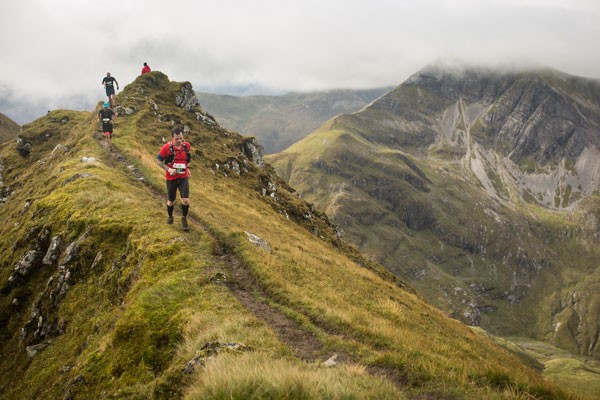Skyline Scotland Ecological Briefing
14th Sep 2017

Salomon Ring of Steel Skyrace™ 2016. A great example of how the race route uses established hill paths.
Ourea Events races are located in Britain’s greatest upland areas that often contain features of outstanding biodiversity value and importance. Occasionally, the features that provide this interest can be vulnerable to the wear and tear that may result from the passage of event participants. The risk of ecological damage is carefully assessed during early stages in the planning process for each event, when every effort is made to avoid sensitive ecological interest areas that could be disturbed by the event.
We are keen to encourage personal route selection choices by participants on our events to further avoid the risk of local ecological disturbance. Additionally we are keen to inform participants about the rich ecology of the areas in which they participate. The following information has been prepared for the 2017 Salomon Skyline Scotland™ event to identify key ecological interest features that contribute to the special character of the event area, with route selection comments to help minimise the risk of localized ecological disturbance.
SALOMON MAMORES VK™
The Salomon Mamores VK™ race follows a short route into the southern edge of the Mamore hills, one of Scotland’s many distinctive highland landscapes. The route crosses an area where glacial action has created a landscape of steep mountainsides with sinuous craggy ridges and deep valley systems that support a diverse assemblage of upland vegetation types, habitats and associated wildlife.
The event area contains one site that has been designated by law in recognition of its special nature conservation interest. This is the Leven Valley Site of Special Scientific Interest (SSSI).
The Leven Valley SSSI extends across steep-sloping land east of Kinlochleven village, containing an extensive example of birch-dominated woodland and represents one of the largest and most intact areas of ancient semi-natural woodland in Lochaber. The site also contains features of national geological importance.
No part of the Salomon Mamores VK™ race route crosses the Leven Valley SSSI or approaches the designated site boundary. As the majority of the Mamores VK race route follows existing hill paths and tracks this minimises the risk of significant disturbance to localised features of undesignated upland vegetation and habitat interest long the route. As a consequence of these considerations, the event will create a very low risk of significant ecological disturbance.
SALOMON BEN NEVIS ULTRA™
The 2017 Salomon Ben Nevis Ultra™ follows a route through a region of the Scottish Highlands that comprise ancient, folded rocks to the south east of the Great Glen Fault. Towards the south of the event area the route ascends Ben Nevis, originally buried deep inside a super-volcano that was last active over 400 million years ago. Several periods of intense glaciation have contributed to development of the present-day landscape of high summits and ridges, defined by deep valleys. The varied landform and geology of the event area have combined to create conditions for the development of specialised upland vegetation and habitats.
A number of special nature conservation interest locations within the event area are recognised by statutory designations, comprising three sites of international nature conservation importance and three sites of national nature conservation importance. These are the Ben Nevis Site of Special Scientific Interest (SSSI) and Special Area of Conservation (SAC), the River Spey SAC, Ness Woods SAC, The Parallel Roads of Lochaber SSSI, and the Glen Tarff SSSI.
The Ben Nevis SSSI and SAC are of importance for their outstanding assemblage of upland vegetation and habitats, principally reflecting the variety of rock types and range of altitude and aspect conditions within the area. Many of the upland vegetation types present are of international nature conservation significance. The designated area is also of importance for the presence of distinctive volcanic geological features, and landscapes created by glacial and post-glacial geomorphological processes. The Ness Woods SAC and Glen Tarff SSSI are locations of international and national woodland nature conservation importance. The River Spey SAC is of particular value for the conservation of several important wildlife species. The Parallel Roads of Lochaber SSSI is noted for a range of distinctive glacial landscape features.
In addition to these designated nature conservation sites the event area contains many other features of more local importance for their distinctive upland vegetation, habitats and wildlife.
The majority of the Salomon Ben Nevis Ultra™ follows existing tracks and hill paths, with localised sections of the race route following intermittent paths and tracks. Ensuring that race participants mainly follow existing paths will avoid the risk of adversely affecting undisturbed areas of notable vegetation, habitat and wildlife. As a consequence of these considerations, the event will create a very low risk of significant ecological disturbance.
SALOMON RING OF STEALL SKYRACE™
The Salomon Ring of Steall Skyrace™ follows a route through an area of Scotland’s upland landscape of exceptional beauty and nature conservation interest. The event area extends across an area of ancient rocks, most of which are over 550 million years old. Glacial action has shaped these rocks to create a landscape of high summits, sinuous craggy ridges and deep valley systems that support a diverse assemblage of upland vegetation types, habitats and associated wildlife.
The event area contains two sites that have been designated by law in recognition of their special nature conservation interest. These are the Ben Nevis Site of Special Scientific Interest (SSSI) and Special Area of Conservation (SAC).
The Ben Nevis SSSI and SAC is of importance for its outstanding upland vegetation and habitat types, and for its upland breeding bird and invertebrate assemblage. The designated area is also of importance for the presence of distinctive volcanic geological features, and landscapes created by glacial and post-glacial geomorphological processes.
The vegetation and habitats reflect the variety of rock types and range of altitude and aspect conditions within the area, including the highest altitude montane vegetation types in Britain. The southern margin of the SSSI and SAC includes important upland woodland within Glen Nevis that is crossed by the Salomon Ring of Steall Skyrace™ route. In addition to these designated nature conservation sites the event area contains many other features of more local importance for their distinctive upland vegetation, habitats and wildlife.
The majority of the Salomon Ring of Steall Skyrace™ route follows existing hill paths and tracks. Section of the race route follow indistinct paths but these are localised and limited in extent. Ensuring that race participants mainly follow existing paths will avoid the risk of adversely affecting undisturbed areas of notable vegetation, habitat and wildlife. As a consequence of these considerations, the event will create a very low risk of significant ecological disturbance.
SALOMON GLEN COE SKYLINE™
The Salomon Glen Coe Skyline™ race follows a route through an area of Scotland’s upland landscape of exceptional beauty and nature conservation interest. The event area extends across the remains of a super-volcano that erupted over 400 million years ago, with subsequent glacial action shaping a landscape of high, rugged mountains comprising a great variety of igneous rock types. The high summits, sinuous craggy ridges and deep valley systems support a diverse assemblage of upland vegetation types, habitats and associated wildlife. These include extensive areas of significant nature conservation interest.
The event area contains four sites that have been designated by law in recognition of their special nature conservation interest. These are the Glencoe Site of Special Scientific Interest (SSSI) and Special Area of Conservation (SAC), the Glen Etive and Glen Fyne Special Protection Area (SPA) and the Leven Valley SSSI.
The Glencoe SSSI and SAC is of importance for its outstanding assemblage of upland vegetation and habitats, principally reflecting the variety of rock types and range of altitude and aspect conditions within the area. Many of the upland vegetation types present are of international nature conservation significance. The designated area is also of importance for the presence of distinctive volcanic geological features, and landscapes created by glacial and post-glacial geomorphological processes. The Glen Etive and Glen Fyne SPA is of international importance for its Golden Eagle populations, and the Leven Valley SSSI is noted for its important ancient woodland habitats and for a range of distinctive geological features.
In addition to these designated nature conservation sites the event area contains many other features of more local importance for their distinctive upland vegetation, habitats and wildlife.
The majority of the Salomon Glen Coe Skyline™ race follows existing hill paths and tracks. Section of the race route that require participants to depart from clearly marked paths and tracks are localised and limited in extent. Ensuring that race participants mainly follow existing paths will avoid the risk of adversely affecting undisturbed areas of notable vegetation, habitat and wildlife. As a consequence of these considerations, the event will create a very low risk of significant ecological disturbance.


